By Sammi Merritt
Amidst the recent UFO and balloon sightings across the United States, many are turning their eyes to the sky in the quest for the unknown. The search for unidentified flying objects and their meaning is not a new trend. At least as early as the 20th century, reports of mysterious flying objects have been filed worldwide, with explanations ranging from rogue weather balloons to full-on alien invasion.
The University of Illinois campus has not been immune to UFO interest over the years. On October 7, 1965, a student reported a UFO sighting outside the Education Building. The report was difficult to verify, however: as a letter to the editor pointed out on October 12, the image of the object printed in the Daily Illini was completely invisible. Curiosity about UFOs on campus has carried on sporadically ever since. Other sightings have been reported, clubs such as the UFO and Outer Space Clubs have been formed, and talks on the subject were advertised in student publications throughout the 1960s and 70s.
In 1973, James B. Kaler, Professor of Astronomy at UIUC, published an explanation of the origins of the UFO phenomenon and the scientific disagreements as to its causes. Despite having personally spied a UFO 20 years prior, he reasoned that the probability was highest that most UFOs were actually stars and other moving objects in the sky, not extraterrestrial observers. Both James Kaler and J. Allen Hynek believed that there was a chance that the UFO sightings were not wholly explainable by the science of their time, but remained firm that the reactions of the US Government and sensational tales of abductions obscured the possibility for true scientific study of the matter.
An element of UFO sightings which is rarely explored is how the rise of this phenomenon affected religious perspectives in the United States. As much as the late 19th-century discovery of dinosaurs challenged the core beliefs of our Victorian ancestors, the potential existence of life outside of our little blue dot presented far greater threats to the beliefs of American Christians. While many brushed off the rash of UFO experiences in the US as hoaxes or misidentified objects, others sought to expand their belief system to encompass the possibility of life beyond Earth, including elements of emerging sciences (and pseudo-sciences) which supported their new worldview.
One of my favorite record series in the University Archives provides a window into the ways that individuals resolved this inner turmoil in the wake of potential new discoveries. The Edwin B. Peebles papers, record series 35/2/50, contains research notes, transcripts, correspondence, and audio tapes concerning Peeble’s interest in the spiritual realm. A resident of Bloomington, IL, Peebles bequeathed his papers and collection of books on spiritualism to the University of Illinois in 1977, likely wishing for the material to be housed alongside the prominent Merton J. Mandeville collection in Parapsychology and the Occult Sciences in the library.
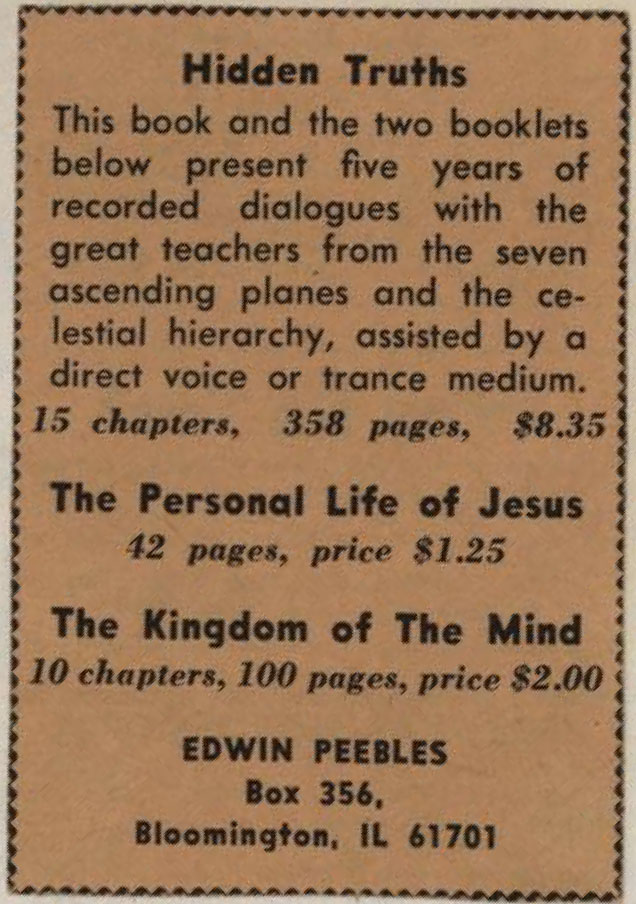

An avid Spiritualist, Peebles published two major works in his lifetime: The Kingdom of the Mind (1973) and Hidden Truths (1974). With the help of several different mediums, Peebles conducted regular séances in order to speak with people who had passed on. He also routinely brought in experts on topics such as religious theory and quantum physics to listen in on the séances and explain the information given by the spirits in scientific terms. Recurring spiritual visitors in these séances include his own mother and sister; biblical characters such as Jesus, the Virgin Mary, her sister Martha, and Moses; known historical figures such as the Buddha, Gandhi, and Pharaoh Tutankhamun; and unknown individuals from the past, including We Li Su, who purported to be from Ancient China.
Speaking through the medium, these characters enlightened Peebles about an infinite spiritual realm, revealing errors in Christian doctrine and the Apostles’ Creed such as the existence of Heaven or Hell and the concept of immaculate conception, sharing instead their firsthand accounts of popular biblical stories. The visitors to these séances shed light on a spiritual world into which all beings pass after death, as well as the ways that they could interact and intercede in affairs in the physical world. One particular element of this belief system which pertains to the hunt for UFOs is the idea of astral projection, through which humans could send their spirits throughout the spirit realm while still alive.
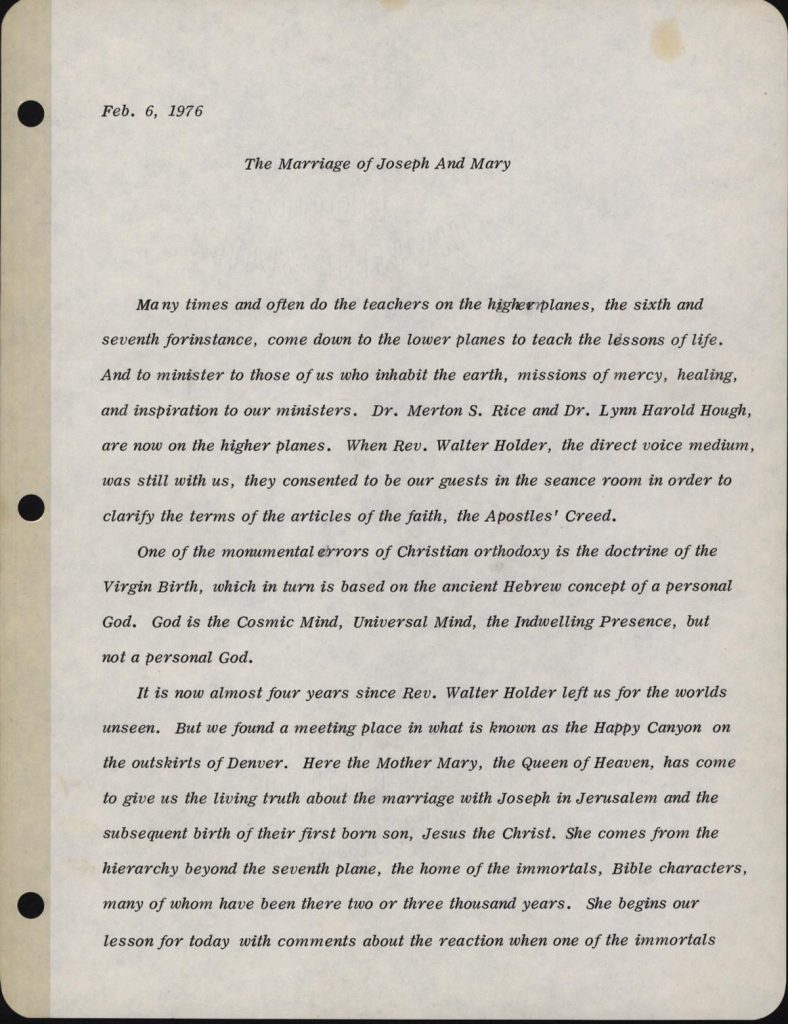

A core element in Peeble’s belief system was that the concept of God was distorted by humans to construct a very inaccurate version of the Christian religion. Key points that are clarified in the séance transcripts include the specific mechanisms behind the miracles of the bible and the origins of specific beliefs in the Christian religion, such as the holy trinity. These séance transcripts are fascinating and lend a unique perspective on some of the ways that spiritualists sought to understand the world around them in the wake of potential extraterrestrial discoveries.
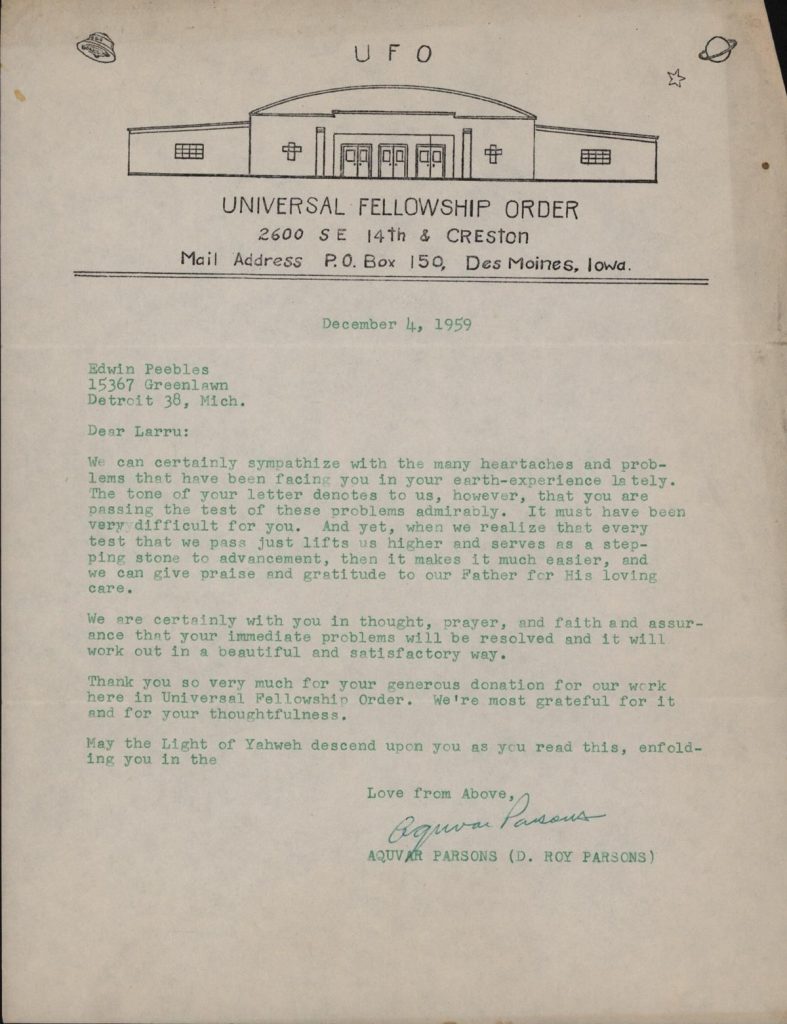
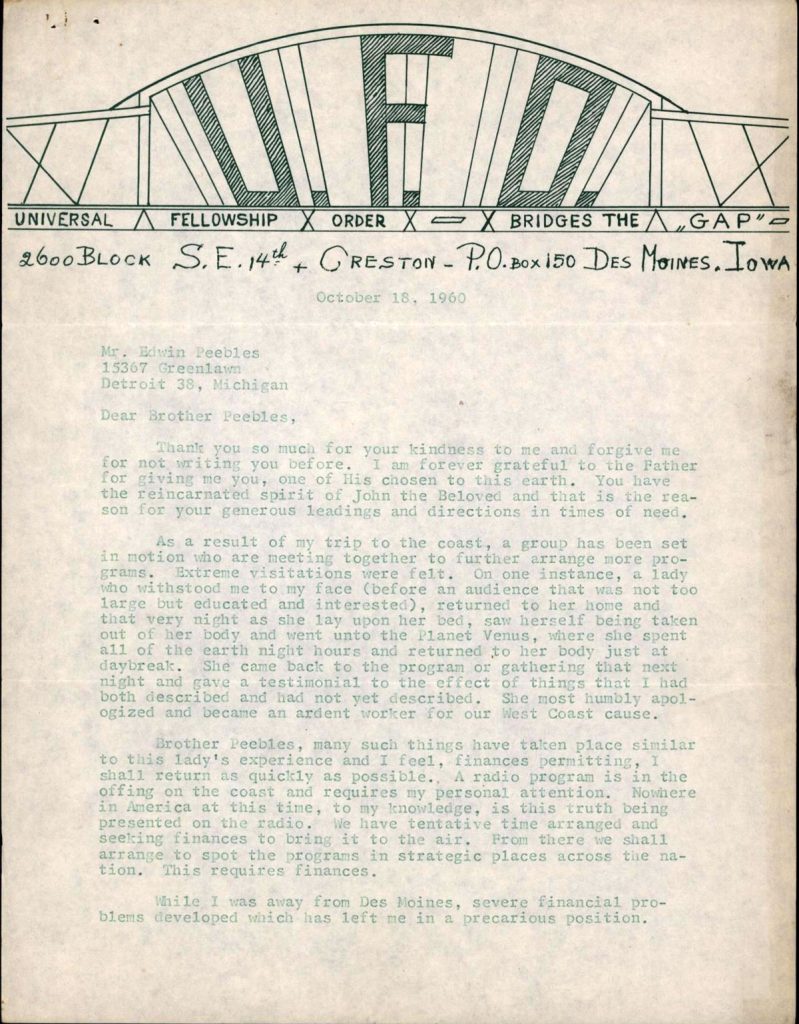
Reverend D. Roy Parsons, leader of the Universal Fellowship Order (U.F.O.) church, discusses other extraterrestrial matters in his correspondence with Peebles (1957-61). The date of their correspondence precedes Peebles’ séance work, which suggests that Parsons’ influence may have been key to the development of Peebles’ later work. In his sermons, Parsons uses his “space name,” Aquvar, and details his own abduction by extraterrestrial beings, who he discovers are actually biblical angels. Relaying information given to him by these beings, Parsons describes the true organization of the universe and solar system, his own travels through the stars, and the transference of the spirit into the cosmos after death. Asserting the veracity of his stories, he exclaims:
“Last Sunday night, I tried to show you how that I had come in contact with what some call space ships or flying saucers. And I emphasize it again tonight! I am in my right mind! I have been in outer space! I have looked down upon this world and other worlds! I have seen them! I have talked with people from another world! This is not my message that I am giving you! This is the message of God! God’s revelation! God’s unveiling!”
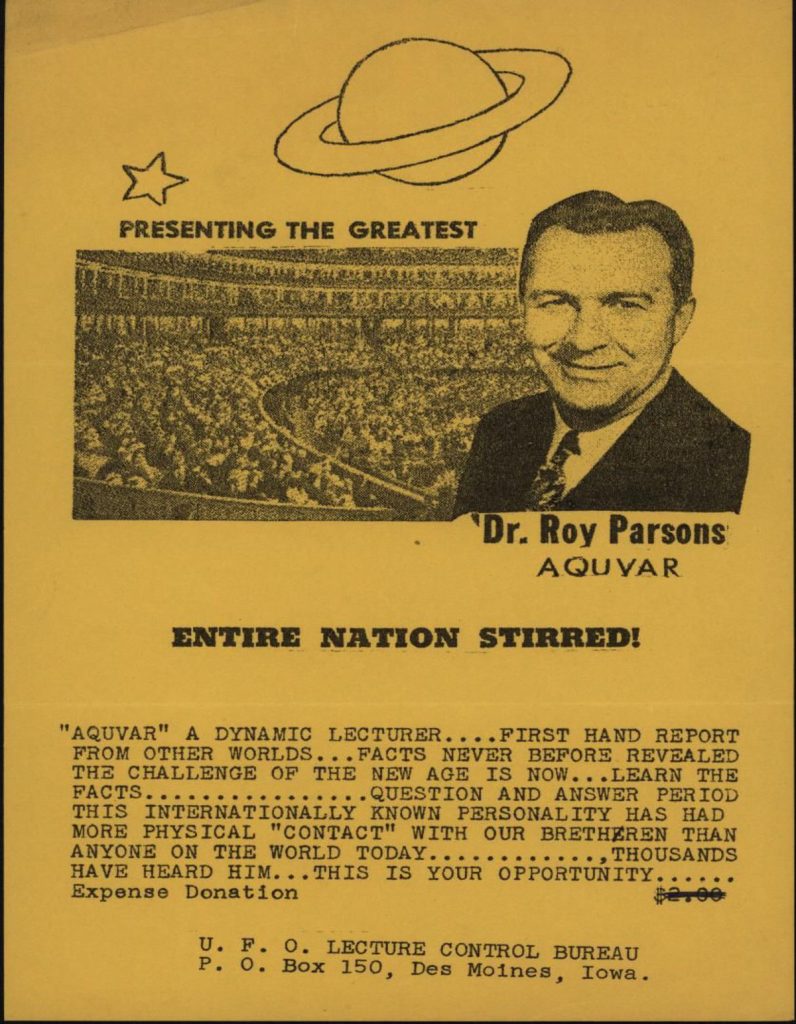

Parsons was not the only preacher who subscribed to the theory that extraterrestrials were actually angels (or vice versa). In the 1970s, Billy Graham made an effort to enfold UFOs into his Christian worldview as well, claiming in his book about angels that the sighted UFOs bore “striking resemblances to angelic aircraft described thousands of years ago in the Old Testament.” The mechanisms through which the angels operated on Earth are strikingly similar among the beliefs of Peebles, Parsons, and Graham.
Reading through the letters and transcripts in the Peebles papers is endlessly fascinating, and demonstrates the many ways that UFO sightings and speculation infiltrated the American psyche. While many sought to deny the sightings or understand them through the contemporary scientific worldview, others sought to use the tools at their disposal to understand how this potential new information about the worlds beyond Earth fit into their religious beliefs – or expand them accordingly.
If you’re interested to learn more, stop by the University Archives to have a look through the Edwin B. Peebles papers.